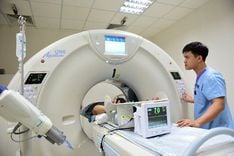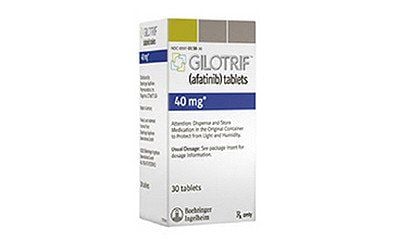This is an automatically translated article.
Post by Master, Doctor Mai Vien Phuong - Head of Department of Gastrointestinal Endoscopy - Department of Medical Examination & Internal Medicine - Vinmec Central Park International General Hospital
Lung cancer is cancer that starts in the lungs. The most common type is non-small cell lung cancer (NSCLC), which accounts for about 80 to 85 percent of all cases. 30% of these cases begin in the cells that make up the lining of the body's cavities and surfaces. Understanding lung cancer and blood clots will help you know how to take better care of your health.
1. What are the symptoms of lung cancer?
The symptoms of non-small cell lung cancer and small cell lung cancer are basically the same. Early symptoms may include:
Cough that lasts or gets worse Cough with phlegm or blood Chest pain that gets worse when you take a deep breath, laugh or cough Hoarseness Shortness of breath Wheezing Weakness and fatigue Loss of appetite and weight loss You may also get recurrent respiratory infections such as pneumonia or bronchitis .
As cancer spreads, additional symptoms depend on where new tumors form. For example, if in:
Lymph nodes : present with lumps, especially in the neck or collarbone Bones: bone pain, especially in the back, ribs or hips Brain or spine: headache, dizziness, balance problems or numbness in hands or feet Liver: yellowing of the skin and eyes (jaundice) Tumors at the top of the lungs can affect the facial nerves, leading to drooping eyelids, small pupils, or lack of sweating on one side of the face. Together these symptoms are known as Horner's syndrome. Tumors can press on a large vein that transports blood between the head, arms, and heart. This can cause swelling of the face, neck, upper chest, and arms.

2. Lung cancer and blood clots
Blood clots are a normal part of the body's response to injury. When you cut yourself, pieces of cells called platelets rush to the wound to seal the wound and stop bleeding.
Other blood clots are not helpful. Unnecessary blood clots can block blood vessels in your brain or lungs. That can lead to dangerous blockages in blood flow. Blood clots can be a side effect of both lung cancer and the medications you take to treat it. It's important to know the warning signs of a blood clot and seek medical attention right away if you think you have one.
Trắc nghiệm: Hiểu về phổi của bạn
Phổi là một tạng lớn rất quan trọng và không thể thiếu trong cơ thể. Việc giữ cho lá phổi của bạn luôn khỏe mạnh, tránh khỏi những bệnh phổ biến về phổi là điều bạn cần lưu ý để giúp cơ thể bạn có thể vận hành tốt. Hãy cùng chúng tôi trả lời nhanh những câu hỏi trắc nghiệm sau sẽ giúp bạn hiểu về phổi của bạn hơn.
Bài dịch từ: webmd.com
The following content is prepared under supervision of Thạc sĩ, Bác sĩ y khoa, Nguyễn Huy Nhật , Nội Hô hấp , Khoa Khám bệnh & Nội khoa - Bệnh viện Đa khoa Quốc tế Vinmec Đà Nẵng
3. The link between lung cancer and blood clots
Lung cancer can increase your risk of blood clots forming inside your deep veins. This is called venous thromboembolism (VTE). People with cancer are four to seven times more likely to form blood clots than people without cancer. Cancer is the cause of about 1 out of 5 cases of VTE.
Deep vein thrombosis (DVT) is a type of VTE. Deep vein thrombosis is a blood clot in one of the veins deep inside your leg and can be serious. A deep vein thrombosis clot can break off and travel through a blood vessel to your lungs. This is called a pulmonary embolism (PE), and can be deadly if it cuts off the blood supply. Blood clots can also travel to your brain and cause a stroke.
Up to 25% of people with cancer will eventually form a blood clot. They can be painful, serious, and must be treated. Blood clots are the second leading cause of death in people with cancer, after the cancer itself.
4. Find out the cause of the disease
Cancer cells damage healthy tissues as they multiply and spread. When your body senses tissue damage, it sends platelets and clotting factors to repair the damage. Part of this repair process involves forming a blood clot to stop excessive bleeding.
Cancer thickens your blood and releases sticky proteins that form blood clots. Tumors can also press on blood vessels as they grow and block blood flow. Whenever blood doesn't move, blood clots can form. Some people with lung cancer are more likely to form blood clots, including those:
Non-small cell lung cancer (NSCLC) adenocarcinoma Stage 3 or 4 lung cancer Chemotherapy or surgery Surgery for cancer Other factors that can increase the risk of blood clots further are:
Over 65 years old Pregnant Smoking Infection Being obese or overweight Having a family history of blood clots Having a blood transfusion for anemia Some cancer treatments also increase the risk of blood clots. Chemotherapy damages blood vessel walls and triggers the release of substances that cause blood clots. Platinum-based chemotherapy drugs such as cisplatin and the targeted drug bevacizumab (Avastin) are known to cause blood clots.
Lung cancer surgery is another risk. When you're on the operating table and off your feet, blood collects in your veins and blood clots can form. The hospital where you have surgery should take special precautions to prevent further blood clots from forming.

5. Symptoms that cause disease
Blood clots do not always cause symptoms. These symptoms may indicate a blockage:
Swelling, heat or pain on the back of the calf and thigh of one leg Skin redness Chest pain when you take a deep breath Sudden shortness of breath Tachycardia Coughing up blood, little more common Call the emergency department or go to the emergency room right away if you have the above symptoms. Blood tests, CT scans, or ultrasounds can confirm whether you have a blood clot. If you have a blood clot, your doctor may give you medicine to dissolve the clot and prevent new clots from forming. These will help you heal while your body dissolves the clot.
6. How can I reduce my risk of blood clots?
A higher risk of blood clots is just one risk, you can take steps to prevent blood clots from forming or take blood thinners like heparin or other medicines to prevent blood clots. Your doctor will weigh the risk of blood clot formation against the risk of bleeding from the blood thinner when deciding to prescribe this medication for you.
You may need blood thinners after lung cancer surgery, when the risk of blood clots is higher. You can also wear socks to keep blood moving in your legs and prevent blood clots from forming while you heal.
If your doctor doesn't talk to you about blood clots, talk to you. Ask about your risk and what you can do to avoid blood clots. Watch out for symptoms like swelling and pain in your legs, and get medical help right away if you do.
Vinmec International General Hospital with a system of modern facilities, medical equipment and a team of experts and doctors with many years of experience in medical examination and treatment, patients can rest assured to visit examination and treatment at the Hospital.
Please dial HOTLINE for more information or register for an appointment HERE. Download MyVinmec app to make appointments faster and to manage your bookings easily.
References
Cancer and pulmonary embolism development. (n.d.). mdanderson.org/patients-family/diagnosis-treatment/emotional-physical-effects/pulmonary-embolism-cancer.html Ma L, et al. (2017). Risk factors and prognosis of pulmonary embolism in patients with lung cancer. journals.lww.com/md-journal/fulltext/2017/04210/risk_factors_and_prognosis_of_pulmonary_embolism.44.aspx Mapes D. (2019). Blood clots: What cancer patients need to know. fredhutch.org/en/news/center-news/2019/03/blood-clots-thrombosis-what-cancer-patients-need-to-know.html Razak NB, et al. (2018). Cancer-associated thrombosis: An overview of mechanisms, risk factors, and treatment. ncbi.nlm.nih.gov/pmc/articles/PMC6209883/ Understanding your risk for excessive blood clotting. (n.d.). https://www.heart.org/en/health-topics/venous-thromboembolism/understand-your-risk-for-excessive-blood-clotting















